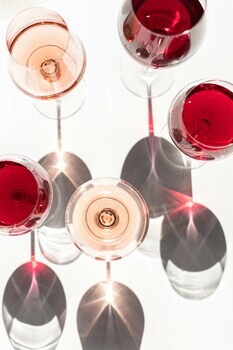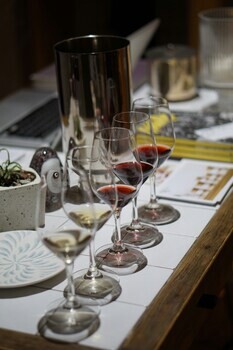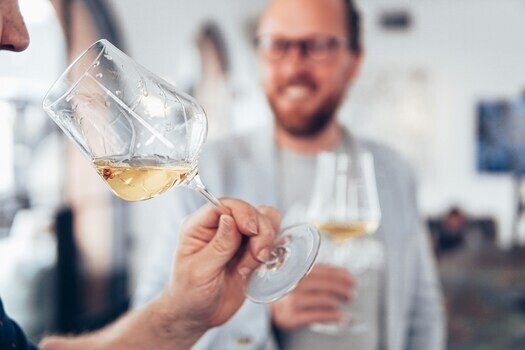A Comprehensive Guide to Wine Tasting Notes
A Comprehensive Guide to Wine Tasting Notes
Tasting wine is more than, well, just tasting it. For tasting wine on a more critical level requires a structured, analytical approach for evaluating a given wine’s every aspect. From its appearance to its finish. And while the employment of this critical approach can only be developed and refined through repeated practice, ultimately, anyone can acquire the techniques to taste like a pro. So, whether you’re new to wine or have some experience, this guide will show you how to taste wine properly. With these wine tasting tips, you’ll learn how to focus your senses, interpret in notation what those senses are telling you, and thus take your wine appreciation to a deeper level.
Step 1: Start in the Right Conditions
Before you whiff your first aroma or that first drop hits your palate, you must ensure that certain conditions have been set. Not doing so can make a huge difference to your experience.
- Choose the Right Glass – A clear, tulip-shaped glass is ideal, as it helps concentrate aromas. Avoid coloured or patterned glassware. Better still, read our comprehensive guide to wine glassware before you select.
- Use Good Lighting – A well-lit space will allow you to properly observe a wine’s colour and clarity.
- Neutral Environment – Strong odours (perfume, food, candles) can interfere with your olfactory and thus skew the accuracy in your tasting note descriptions.
- Proper Serving Temperature – A crucial factor. Serving a wine at the wrong temperature can profoundly affect the delivery of aroma and flavour. This is especially true of whites, where overchilling can so easily blot out nuance and detail, and, conversely, where faults are also masked. Such that you’re better off serving them underchilled than over. In fact, some sommeliers prefer to taste white wines at room temperature. For here a flawed wine has nowhere to hide!
General guidelines:
- Sparkling & Light Whites: 6-10°C (43-50°F)
- Full-bodied Whites & Light Reds: 10-14°C (50-57°F)
- Full-bodied Reds: 15-18°C (59-65°F)
Step 2: Look – Evaluating the Wine’s Appearance
Your first contact with a wine. The first moment you perceive its colour, brilliance or depth of hue, and viscosity. When you inspect what the French call a wine’s ‘robe.’
To do this, hold the glass by the stem and tilt it slightly against a white background. Now observe:
Hue & Intensity
The two parameters by which a wine’s colour is evaluated, for which the following terms are typically used as common descriptors:
- Red wines: purple, ruby, garnet, tawny, brown.
- White wines: lemon-green, lemon, gold, amber, brown.
- Rosé wines: pink, salmon, orange.

When estimating grape variety, age, and style, here are some common indicators:
- Whites: Pale yellow-green (young, cool climate) → Golden (aged, oak influence)
- Reds: Bright ruby (young, cool climate) → Deep purple (full-bodied, high tannin) → Brick or brown (aged wine)
Clarity – A clear wine suggests good winemaking, while excessive cloudiness may indicate faults.
Viscosity (‘legs’ or ‘tears’) – Swirl the wine and watch how it coats the glass. Slower, thicker tears suggest higher alcohol or sugar content.
NB: Older red wines may have a slightly brownish rim, while aged whites may turn deeper gold. This is normal and part of the ageing process.
Step 3: Interpreting Aromas
Swirl the wine in the glass to release its aromatic compounds, then take a few short sniffs before a steady inhale.
Aroma Categories
Primary Aromas – Come from the grape itself and include fruit, floral, and herbal notes:
- White wines: Citrus, stone fruit, tropical fruit, floral, herbs
- Red wines: Red or black berries, plums, cherries, spices
Secondary Aromas – Come from the winemaking process, particularly fermentation and ageing:
- Butter, vanilla, toast, sweet spice (oak ageing)
- Yeasty, fresh bread, brioche (Champagne)
Tertiary Aromas – Develop with age, often giving more complex scents:
- Dried fruit, nuts, honey (aged whites)
- Leather, tobacco, tomato leaf forest floor, soy (aged reds)
Step 4: Taste – Evaluating Structure & Balance
Now for the last of the major senses in the process. Sip slightly, sip gently. Purse the lips then incrementally suck small draws of air through the wine. This will liberate its full flavours by releasing its more volatile components. Swirl, then let the wine coat your entire mouth. Notice how the different aspects of the wine’s taste correspond with the reaction to different parts of the mouth, tongue and gums:
1. Sweetness (Residual Sugar)
- Dry wines have no ‘residual sugar’ left over from the fermentation process and therefore do not register on the palate as such. Classic examples will be sauvignon blanc or pinot noir.
- Off-dry and sweet wines register on the tip of the tongue as experienced in the dessert wines of Sauternes or ‘demi-sec’ Vouvray (chenin blanc).
2. Acidity
- Registering along the sides of the tongue, acidity makes a wine feel fresh, vibrant and mouthwatering. Wines high in acidity are crisp and zippy, while low-acid wines feel softer. Wines with insufficient acidity may lack structure and are often referred to as being ‘flabby’.
- High-acidity examples include riesling and champagne whereas viognier and grenache are typically ones with lower levels.
3. Tannins
- Tannins are mostly in red wines and come from grape skins, stems and pips, as well as oak barrel-ageing. They’re what give your gums that grippy sensation, similar to what they experience when you drink black tea. More importantly, however, is the crucial role tannins play in defining a wine’s overall structure.
- High tannins = bold, structured wines (cabernet sauvignon, nebbiolo).
- Low tannins = smooth, easy-drinking wines (pinot noir, gamay).

4. Alcohol
- A wine’s level of alcohol–its ABV%–is a principal contributor to a wine’s body and weight. On the palate and finish, a higher level gives a warming sensation, as well as a subtle perception of sweetness. E.g. a German riesling at just 9% ABV will feel far lighter on the palate than will an Australian shiraz weighing in at 15%.
- However, a faulty wine with insufficiently integrated or balanced alcohol will result in an excessively warm, sweet, vaporous and overpowering effect on the palate and in the throat. In such cases, a wine may be described as ‘hot’.
5. Body
- This refers to its weightiness on the palate; how dense or voluminous it feels. You’ll often hear the more literal term ‘mouth-feel’. Much of this sensation will owe to the extent of maceration and extraction during the fermentation process, as well as to alcohol levels (as cited above).
- Light-bodied wines will come across more delicately, while full-bodied wines feel rich and powerful. E.g.: pinot noir (light-bodied) vs. malbec (full-bodied).
6. Texture
- Similar to ‘body’, ‘texture’ refers to how a wine feels in your mouth–its ‘mouth-feel’, as critics literally refer to it as. The difference here, however, is that texture can be affected by all factors cited above.
- Tannins:
- High tannins = firm, structured, astringent texture (e.g., young cabernet sauvignon, nebbiolo).
- Soft tannins = smooth, silky, or velvety texture (e.g., Beaujolais, pinot noir).
- Acidity:
- High acidity = bright, zesty, or even racy mouthfeel (e.g., sauvignon blanc, riesling, chenin blanc).
- Low acidity = rounder, softer texture (e.g., viognier, grenache).
- Alcohol:
- High alcohol (14%+) = fuller, richer, weightier feel (e.g., Australian shiraz, grenache).
- Low alcohol (<12%) = lighter, more delicate texture (e.g., German riesling, Beaujolais)
- Residual Sugar:
- Sweet wines (e.g., Sauternes, Port) have a thick, coating texture.
- Off-dry wines (e.g., Vouvray Demi-Sec, lower-alcohol German riesling) feel smooth and rounded.
- Oak Ageing:
- Wines aged in new oak (e.g., chardonnay, Rioja) often feel richer and smoother.
- Wines aged in neutral oak or stainless steel tend to be crisper and leaner.
- Bubbles (‘Mousse’) in Sparkling Wines:
- Fine, delicate bubbles = silky, creamy mousse (e.g., vintage champagne).
- Larger, aggressive bubbles = sharper, more effervescent texture (e.g., prosecco, cava).
7. Flavour Characteristics: Intensity & Complexity
- Generally speaking, on the palate these will conform to what’s been experienced on the nose.
- Are the flavours layered and develop as they move across the palate or do they lack dimension?
- However they seem, you can divide the process into three distinct stages in which there may variance in both flavour profile and intensity:
- The immediate impression, which may vary in length.
- The mid-palate, where a wine’s full flavour becomes apparent.
- The finish, when and where all flavours linger after the wine has been either swallowed or spat out.
8. Finish (Aftertaste)
- As above, here’s where complexity and length are assessed to determine whether a wine is of sufficient quality or not. Do the flavours identified on the palate linger after spitting or swallowing, or is the finish ‘short’?
- An effective technique to help in this assessment is to breathe out your nostrils after having consumed the wine. Here, a wine of decent quality should still show a flavourful vaporous presence as you exhale.
- Keep in mind, however, that length alone does not determine the quality of a wine’s finish. For if its length then reveals faulty flavours or ones not conforming to what was experienced on the palate, this will significantly impact a wine’s final assessment.

Step 5: Evaluate, Structure Your Notes
Once you’ve observed, smelled, and tasted, take a moment to reflect, then refer back to the notes you’ve been taking throughout the process. These will be central to informing your conclusion on the quality of what’s been tasted.
- Is the wine balanced? Are fruit, acidity, tannin, alcohol and oak (if present) harmonised?
- Is it complex? Does it change in the glass or offer multiple layers of aroma and flavour?
- Do you like it? Personal preference matters just as much as professional analysis!
If you’re interested in improving your tasting skills, it’s a good idea to keep track of your impressions and experiences with a wine journal. A ‘wine diary’, if you will. Over time, you’ll start to recognise certain patterns in your preferences as well as develop confidence and greater precision in your ability to describe what you’re tasting.
Don’t Do This
- Taste too quickly – Give the wine time to open up and evolve in the glass.
- Taste Near Aromatic Sources – Again, avoid wearing any fragrances on your person or tasting near any sources of scents/odours (i.e. candles, cooking, etc).
- Neglect Proper Serving Temperatures – Utterly crucial. So, to repeat: over-chilling whites or serving reds too warm will mute their nuances and overall character.
- Let Labels Influence You – Focus on what’s in the glass, not just brand names or price.

Observe, Build, Enjoy
Above all, employing a comprehensive approach to wine tasting isn’t about having a perfect palate–no-one has. It’s about paying attention and building experience. And you won’t be surprised to hear that the more you practice, the more discerning your palate will become. Because what’s key here is building confidence. Which means that the more wines you taste–and the more regularly you taste them–the more adept you’ll become at recognising aromas, flavours, and styles.
Wherever, whenever you engage a glass, then, these steps will help you evaluate wine with greater awareness and enjoyment - with ‘enjoyment’ being the operative word!
-- David Adamick, Mr.Wheeler Wine
